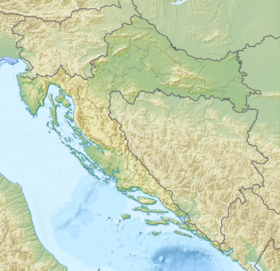Battle of Mursa Major
| Battle of Mursa | |||||||
|---|---|---|---|---|---|---|---|
| Part of the Roman civil war of 350–353 | |||||||
| |||||||
| Belligerents | |||||||
| Roman Empire | Roman Empire | ||||||
| Commanders and leaders | |||||||
| Magnentius | Constantius II | ||||||
| Strength | |||||||
| 60,000[3] | |||||||
| Casualties and losses | |||||||
|
23,760[a][4]–24,000 Very large number of deaths[2] | 24,000[b][5]–30,000[4] | ||||||
Location of the battle within modern Croatia | |||||||
The Battle of Mursa was fought on 28 September 351 between the eastern Roman armies led by the Emperor Constantius II and the western forces supporting the usurper Magnentius. It took place at Mursa, near the Via Militaris in the province of Pannonia (modern Osijek, Croatia). The battle, one of the bloodiest in Roman history, was a pyrrhic victory for Constantius.
Background
Following
After attempting to impose his authority over Carthage and being blocked, Constantine II attacked his brother Constans in 340, but was ambushed and killed near Aquileia in northern Italy.[10] Constans took possession of the provinces of the west, and ruled for ten years over two-thirds of the Roman world.[10] In the meantime, Constantius was engaged in a difficult war against the Persians under Shapur II in the east.[10]
Rebellion of Magnentius
In 350, the mismanagement of Constans had alienated his generals and civilian officials and Magnentius had himself proclaimed Augustus of the west, resulting in the murder of Constans.[11] Magnentius quickly marched his army into Italy, appointing Fabius Titanius as praefectus urbi consolidating his influence over Rome.[11] By the time Magnentius' army arrived at the Julian passes, Vetranio, Constans' lieutenant in Illyricum, had been declared Augustus by his troops.[11] Magnentius initially attempted a political dialogue with Constantius and Vetranio, but the rebellion of Nepotianus in Rome changed his intentions from joining the Constantian dynasty to supplanting it.[12] It was during this rebellion that Magnentius promoted his brother Decentius to Caesar.[11]
Constantius' reaction was limited.[12] Already involved in a war with the Sasanian Empire, he was in no position to deal with Magnentius or Vetranio.[12] Following Shapur's retreat from Nisibis, Constantius marched his army to Serdica meeting Vetranio with his army.[13] Instead of a battle, both Constantius and Vetranio appeared before the latter's army, and Vetranio agreed to abdicate.[14] Constantius then advanced west with his reinforced army to encounter Magnentius.[3]
The battle
Magnentius marched an army of around 36,000 Gallic infantry, auxilia palatinae, Franks, and Saxons down the Via Militaris and besieged Mursa.[2] His siege was short-lived as Constantius' army arrived and Magnentius was forced to retreat. Magnentius formed up his army on the open plain north-west of Mursa, near the Drava River.
Once his army was deployed, Constantius sent his praetorian prefect,
Aftermath
Following his victory at Mursa, Constantius chose not to pursue the fleeing Magnentius, instead spending the next ten months recruiting new troops and retaking towns still loyal to Magnentius.
Historiography of the battle
Numerous contemporary writers considered the loss of Roman lives at Mursa a disaster for the Roman Empire. Crawford states the barbarian contingents took the lion's share of the casualties,[4] and yet the losses suffered at Mursa, according to Eutropius, could have won triumphs from foreign wars and brought peace.[19] Zosimus called the battle at Mursa a major disaster, with the army so weakened that it could not counter barbarian incursions,[20] while modern academics have labeled the battle a pyrrhic victory for Constantius.[4]
Notes
References
- ^ Omissi 2018, p. 168.
- ^ a b c d Angelov 2018, p. 1059.
- ^ a b Crawford 2016, p. 77.
- ^ a b c d e f g Crawford 2016, p. 80.
- ^ a b c Potter 2004, p. 473.
- ^ a b Crawford 2016, pp. 29–30.
- ^ Leadbetter 1998, p. 80.
- ^ Crawford 2016, p. 31.
- ^ Crawford 2016, p. 35.
- ^ a b c Crawford 2016, p. 64.
- ^ a b c d Barnes 1993, p. 101.
- ^ a b c Crawford 2016, p. 74.
- ^ Crawford 2016, p. 75.
- ^ Crawford 2016, p. 76.
- ^ Crawford 2016, p. 78.
- ^ Potter 2004, p. 474.
- ^ Crawford 2016, pp. 80–81.
- ^ a b c Crawford 2016, p. 81.
- ^ Lee 2007, p. 73.
- ^ Potter 2004, pp. 473–474.
Sources
- Angelov, Alexander (2018). "Mursa and Battles of Mursa". In Nicholson, Oliver (ed.). ISBN 978-0-19-866277-8.
- ISBN 0-674-05067-3.
- Crawford, Peter (2016). Constantius II: Usurpers, Eunuchs, and the Antichrist. Pen & Sword. ISBN 978-1-78340-055-3.
- Drinkwater, John F. (2022). "The battle Of Mursa, 351: causes, course, and consequences". Journal of Late Antiquity. 15: 131–159.
- Leadbetter, Bill (1998). "The illegitimacy of Constantine and the birth of the tetrarchy". In Lieu, Samuel N. C.; ISBN 0-415-10747-4.
- Lee, A.D. (2007). War in Late Antiquity. Blackwell Publishing. ISBN 978-0-631-22925-4.
- Omissi, Adrastos (2018). Emperors and Usurpers in the Later Roman Empire: Civil War, Panegyric, and the Construction of Legitimacy. Oxford University Press.
- ISBN 0-415-10058-5.
- ISBN 978-1-85109-667-1.

